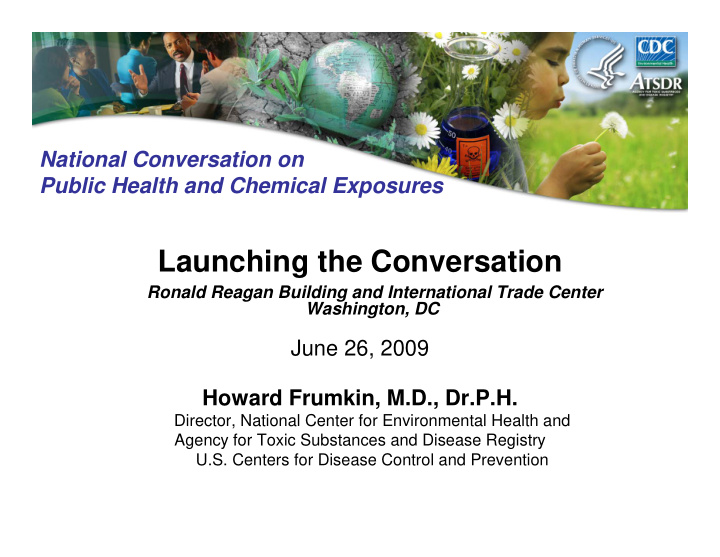



National Conversation on Public Health and Chemical Exposures Launching the Conversation Ronald Reagan Building and International Trade Center Washington, DC June 26, 2009 Howard Frumkin, M.D., Dr.P.H. Director, National Center for Environmental Health and Agency for Toxic Substances and Disease Registry U.S. Centers for Disease Control and Prevention
Our Vision Chemicals are used and managed in ways that are safe and healthy for all people
This vision requires… • Accurate information on chemical use, exposure pathways, and exposure levels; • Scientific understanding of how chemicals affect health; • Policies and practices that prevent or reduce harmful exposures; • Effective prevention of, preparedness for, and response to chemical emergencies; • Elimination of inequities in exposure; • A well-informed and engaged public and health care provider network; and • Close collaboration and coordination among partner organizations and agencies.
Are we there yet?
40+ years of effort Not to mention… • Scientific advances • Organizations • Degree programs • Etc.
A complex “system” • ATSDR • DOE • State and local agencies • CDC • DHS • Professional associations – NCEH • FDA • Industry – NIOSH • NIEHS/NTP • Commerce • CSB • OSHA • Environmental groups • CPSC • USGS • Community groups • EPA • USDA • Academia • DOD • Tribal groups
Important advances
Room for improvement • Accurate information on chemical use, exposure pathways, and exposure levels; • Scientific understanding of how chemicals affect health; • Policies and practices that prevent or reduce harmful exposures; • Effective prevention of, preparedness for, and response to chemical emergencies; • Elimination of inequities in exposure; • A well-informed and engaged public and health care provider network; and • Close collaboration and coordination among partner organizations and agencies.
Changed landscape • Recognition of many exposure pathways • Recognition of broad range of health outcomes • Biomonitoring • Large numbers of chemicals • New approaches to toxicity testing • Environmental justice • Green chemistry
Our Goal • Develop an action agenda for strengthening the public health approach to chemical exposures – Identify: gaps, redundancies, priorities and solutions – NCEH/ATSDR focus: Improving our work – Close collaboration with other federal agencies – Engagement with non-Federal partners (state and local agencies, communities, NGOs, academia, private sector)
Shared values • Safe, healthy, wholesome environments • Care for vulnerable populations • Responsible stewardship for future generations • Value of prevention • Reliance on good science • Efficient use of resources • Good government
Key aspects of the Conversation • Respect for ongoing initiatives – No wrenches in the works – Enhance and support with good ideas
Key aspects of the Conversation • Respect for ongoing initiatives – No wrenches in the works – Enhance and support with good ideas • No mandates
Key aspects of the Conversation • Respect for ongoing initiatives – No wrenches in the works – Enhance and support with good ideas • No mandates • Transparent, open, inclusive, participatory
Help us launch the conversation Today:
Breakout session topics • Monitoring • Scientific Understanding • Policies and Practices • Chemical Emergencies • Serving Communities • Education and Communication
Work group membership nomination process • Call for nominations starting today • Taking nominations through July 20, 2009 • www.2009nationalconversation.com
Public participation • Interactive on-line discussion platform • Citizen conversation toolkit • Sector-based meetings • Public meetings
Outcomes • Early wins • Actionable set of recommendations that we can move to achieve quickly
Stay informed & participate Web: www.atsdr.cdc.gov/nationalconversation Email: nationalconversation@cdc.gov
Recommend
More recommend